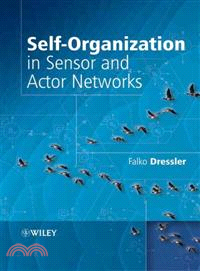Self - Organization In Sensor And Actor Networks
商品資訊
ISBN13:9780470028209
出版社:John Wiley & Sons Inc
作者:Dressler
出版日:2007/11/16
裝訂/頁數:精裝/386頁
規格:24.8cm*17.8cm*2.5cm (高/寬/厚)
定價
:NT$ 5622 元優惠價
:90 折 5060 元
若需訂購本書,請電洽客服 02-25006600[分機130、131]。
商品簡介
作者簡介
目次
相關商品
商品簡介
Self-Organization in Sensor and Actor Networks explores self-organization mechanisms and methodologies concerning the efficient coordination between intercommunicating autonomous systems.Self-organization is often referred to as the multitude of algorithms and methods that organise the global behaviour of a system based on inter-system communication. Studies of self-organization in natural systems first took off in the 1960s. In technology, such approaches have become a hot research topic over the last 4-5 years with emphasis upon management and control in communication networks, and especially in resource-constrained sensor and actor networks. In the area of ad hoc networks new solutions have been discovered that imitate the properties of self-organization. Some algorithms for on-demand communication and coordination, including data-centric networking, are well-known examples.
Key features include:
Detailed treatment of self-organization, mobile sensor and actor networks, coordination between autonomous systems, and bio-inspired networking.
Overview of the basic methodologies for self-organization, a comparison to central and hierarchical control, and classification of algorithms and techniques in sensor and actor networks.
Explanation of medium access control, ad hoc routing, data-centric networking, synchronization, and task allocation issues.
Introduction to swarm intelligence, artificial immune system, molecular information exchange.
Numerous examples and application scenarios to illustrate the theory.
Self-Organization in Sensor and Actor Networks will prove essential reading for students of computer science and related fields; researchers working in the area of massively distributed systems, sensor networks, self-organization, and bio-inspired networking will also find this reference useful.
Key features include:
Detailed treatment of self-organization, mobile sensor and actor networks, coordination between autonomous systems, and bio-inspired networking.
Overview of the basic methodologies for self-organization, a comparison to central and hierarchical control, and classification of algorithms and techniques in sensor and actor networks.
Explanation of medium access control, ad hoc routing, data-centric networking, synchronization, and task allocation issues.
Introduction to swarm intelligence, artificial immune system, molecular information exchange.
Numerous examples and application scenarios to illustrate the theory.
Self-Organization in Sensor and Actor Networks will prove essential reading for students of computer science and related fields; researchers working in the area of massively distributed systems, sensor networks, self-organization, and bio-inspired networking will also find this reference useful.
作者簡介
Dr. Falko Dressler is Assistant Professor at the Department of Computer Sciences, University of Erlangen, Germany and, since 2004, Head of the Autonomic Networking Group. He has made many contributions in the area of quality of service in communication networks (IP, multicast, sensor networks), network security (intrusion detection, high-speed monitoring, IP traceback), ad hoc wireless sensor networks (communication paradigms, congestion control), and bio-inspired networking (lessons learnt from molecular biology to be adapted to communication networks). His areas of expertise include distributed systems and communication networks, self-organizing autonomous sensor/actuator networks and bio-inspired networking.
目次
Foreword.
Preface.
About the Author.
List of Abbreviations.
I Self-Organization.
1 Introduction to Self-Organization.
1.1 Understanding self-organization.
1.2 Application scenarios for self-organization.
2 System Management and Control – A Historical Overview.
2.1 System architecture.
2.2 Management and control.
2.2.1 Centralized control.
2.2.2 Distributed systems.
2.2.3 Self-organizing systems.
3 Self-Organization – Context and Capabilities.
3.1 Complex systems.
3.2 Self-organization and emergence.
3.3 Systems lacking self-organization.
3.3.1 External control.
3.3.2 Blueprints and templates.
3.4 Self-X capabilities.
3.5 Consequences of emergent properties.
3.6 Operating self-organizing systems.
3.6.1 Asimov’s Laws of Robotics.
3.6.2 Attractors.
3.7 Limitations of self-organization.
4 Natural Self-Organization.
4.1 Development of understandings.
4.2 Examples in natural sciences.
4.2.1 Biology.
4.2.2 Chemistry.
4.3 Differentiation self-organization and bio-inspired.
4.3.1 Exploring bio-inspired.
4.3.2 Bio-inspired techniques.
4.3.3 Self-organization vs. bio-inspired.
5 Self-Organization in Technical Systems.
5.1 General applicability.
5.1.1 Autonomous systems.
5.1.2 Multi-robot systems.
5.1.3 Autonomic networking.
5.1.4 Mobile Ad Hoc Networks.
5.1.5 Sensor and Actor Networks.
5.2 Operating Sensor and Actor Networks.
6 Methods and Techniques.
6.1 Basic methods.
6.1.1 Positive and negative feedback.
6.1.2 Interactions among individuals and with the environment.
6.1.3 Probabilistic techniques.
6.2 Design paradigms for self-organization.
6.2.1 Design process.
6.2.2 Discussion of the design paradigms.
6.3 Developing nature-inspired self-organizing systems.
6.4 Modeling self-organizing systems.
6.4.1 Overview to modeling techniques.
6.4.2 Differential equation models.
6.4.3 Monte Carlo simulations.
6.4.4 Choosing the right modeling technique.
Appendix I Self-Organization – Further Reading.
II Networking Aspects: Ad Hoc and Sensor Networks.
7 Mobile Ad Hoc and Sensor Networks.
7.1 Ad hoc networks.
7.1.1 Basic properties of ad hoc networks.
7.1.2 Mobile Ad Hoc Networks.
7.2 Wireless Sensor Networks.
7.2.1 Basic properties of sensor networks.
7.2.2 Composition of single sensor nodes.
7.2.3 Communication in sensor networks.
7.2.4 Energy aspects.
7.2.5 Coverage and deployment.
7.2.6 Comparison between MANETs and WSNs.
7.2.7 Application examples.
7.3 Challenges and research issues.
7.3.1 Required functionality and constraints.
7.3.2 Research objectives.
8 Self-Organization in Sensor Networks.
8.1 Properties and objectives.
8.2 Categorization in two dimensions.
8.2.1 Horizontal dimension.
8.2.2 Vertical dimension.
8.3 Methods and application examples.
8.3.1 Mapping with primary self-organization methods.
8.3.2 Global state.
8.3.3 Location information.
8.3.4 Neighborhood information.
8.3.5 Local state.
8.3.6 Probabilistic techniques.
9 Medium Access Control.
9.1 Contention-based protocols.
9.2 Sensor MAC.
9.2.1 Synchronized listen/sleep cycles.
9.2.2 Performance aspects.
9.2.3 Performance evaluation.
9.3 Power-Control MAC protocol.
9.4 Conclusion.
10 Ad Hoc Routing.
10.1 Overview and categorization.
10.1.1 Address-based routing vs. data-centric forwarding.
10.1.2 Classification of ad hoc routing protocols.
10.2 Principles of ad hoc routing protocols.
10.2.1 Destination Sequenced Distance Vector.
10.2.2 Dynamic Source Routing.
10.2.3 Ad Hoc on Demand Distance Vector.
10.2.4 Dynamic MANET on Demand.
10.3 Optimized route stability.
10.4 Dynamic address assignment.
10.4.1 Overview and centralized assignment.
10.4.2 Passive Duplicate Address Detection.
10.4.3 Dynamic Address Allocation.
10.5 Conclusion.
11 Data-Centric Networking.
11.1 Overview and classification.
11.1.1 Data dissemination.
11.1.2 Network-centric operation.
11.1.3 Related approaches.
11.2 Flooding, gossiping, and optimizations.
11.2.1 Flooding.
11.2.2 Pure gossiping.
11.2.3 Optimized gossiping.
11.3 Agent-based techniques.
11.4 Directed diffusion.
11.4.1 Basic algorithm.
11.4.2 Mobility support.
11.4.3 Energy efficiency.
11.5 Data aggregation.
11.5.1 Principles and objectives.
11.5.2 Aggregation topologies.
11.6 Conclusion.
12 Clustering.
12.1 Principles of clustering.
12.1.1 Requirements and classification.
12.1.2 k-means.
12.1.3 Hierarchical clustering.
12.2 Clustering for efficient routing.
12.2.1 Low-Energy Adaptive Clustering Hierarchy.
12.2.2 Hybrid Energy-Efficient Distributed Clustering Approach.
12.3 Conclusion.
Appendix II Networking Aspects – Further reading.
III Coordination and Control: Sensor and Actor Networks.
13 Sensor and Actor Networks.
13.1 Introduction.
13.1.1 Composition of SANETs – an example.
13.1.2 Properties and capabilities.
13.1.3 Components of SANET nodes.
13.1.4 Application examples.
13.2 Challenges and research objectives.
13.2.1 Communication and coordination.
13.2.2 Collaboration and task allocation.
13.3 Limitations.
14 Communication and Coordination.
14.1 Synchronization vs. coordination.
14.1.1 Problem statement.
14.1.2 Logical time.
14.1.3 Coordination.
14.2 Time synchronization in WSNs and SANETs.
14.2.1 Requirements and objectives.
14.2.2 Conventional approaches.
14.2.3 Algorithms for WSNs.
14.3 Distributed coordination.
14.3.1 Scalable coordination.
14.3.2 Selected algorithms.
14.3.3 Integrated sensor-actor and actor-actor coordination.
14.3.4 Problems with selfish nodes.
14.4 In-network operation and control.
14.5 Conclusion.
15 Collaboration and Task Allocation.
15.1 Introduction to MRTA.
15.1.1 Primary objectives.
15.1.2 Classification and taxonomy.
15.2 Intentional cooperation – auction-based task allocation.
15.2.1 Open Agent Architecture.
15.2.2 MURDOCH.
15.2.3 Dynamic negotiation algorithm.
15.3 Emergent cooperation.
15.3.2 Stimulation by state.
15.4 Conclusion.
Appendix III Coordination and Control – Further reading.
IV Self-Organization Methods in Sensor and Actor Networks.
16 Self-Organization Methods – Revisited.
16.1 Self-organization methods in SANETs.
16.2 Positive and negative feedback.
16.3 Interactions among individuals and with the environment .
16.4 Probabilistic techniques.
17 Evaluation Criteria.
17.1 Scalability.
17.2 Energy considerations.
17.2.1 Energy management.
17.2.2 Transmission power management.
17.3 Network lifetime.
17.3.1 Definition of network lifetime.
17.3.2 Scenario-based comparisons of network lifetime.
V Bio-inspired Networking.
18 Bio-inspired Systems.
18.1 Introduction and overview.
18.1.1 Ideas and concepts.
18.1.2 Bio-inspired research fields.
18.2 Swarm Intelligence.
18.2.1 Principles of ant foraging.
18.2.2 Ant-based routing.
18.2.3 Ant-based task allocation.
18.3 Artificial Immune System.
18.3.1 Principles of the immune system.
18.3.2 Application examples.
18.4 Cellular signaling pathways.
18.4.1 Introduction to signaling pathways.
18.4.2 Applicability in SANETs.
18.5 Conclusion.
Appendix IV Bio-inspired Networking – Further reading.
Bibliography.
Index.
Preface.
About the Author.
List of Abbreviations.
I Self-Organization.
1 Introduction to Self-Organization.
1.1 Understanding self-organization.
1.2 Application scenarios for self-organization.
2 System Management and Control – A Historical Overview.
2.1 System architecture.
2.2 Management and control.
2.2.1 Centralized control.
2.2.2 Distributed systems.
2.2.3 Self-organizing systems.
3 Self-Organization – Context and Capabilities.
3.1 Complex systems.
3.2 Self-organization and emergence.
3.3 Systems lacking self-organization.
3.3.1 External control.
3.3.2 Blueprints and templates.
3.4 Self-X capabilities.
3.5 Consequences of emergent properties.
3.6 Operating self-organizing systems.
3.6.1 Asimov’s Laws of Robotics.
3.6.2 Attractors.
3.7 Limitations of self-organization.
4 Natural Self-Organization.
4.1 Development of understandings.
4.2 Examples in natural sciences.
4.2.1 Biology.
4.2.2 Chemistry.
4.3 Differentiation self-organization and bio-inspired.
4.3.1 Exploring bio-inspired.
4.3.2 Bio-inspired techniques.
4.3.3 Self-organization vs. bio-inspired.
5 Self-Organization in Technical Systems.
5.1 General applicability.
5.1.1 Autonomous systems.
5.1.2 Multi-robot systems.
5.1.3 Autonomic networking.
5.1.4 Mobile Ad Hoc Networks.
5.1.5 Sensor and Actor Networks.
5.2 Operating Sensor and Actor Networks.
6 Methods and Techniques.
6.1 Basic methods.
6.1.1 Positive and negative feedback.
6.1.2 Interactions among individuals and with the environment.
6.1.3 Probabilistic techniques.
6.2 Design paradigms for self-organization.
6.2.1 Design process.
6.2.2 Discussion of the design paradigms.
6.3 Developing nature-inspired self-organizing systems.
6.4 Modeling self-organizing systems.
6.4.1 Overview to modeling techniques.
6.4.2 Differential equation models.
6.4.3 Monte Carlo simulations.
6.4.4 Choosing the right modeling technique.
Appendix I Self-Organization – Further Reading.
II Networking Aspects: Ad Hoc and Sensor Networks.
7 Mobile Ad Hoc and Sensor Networks.
7.1 Ad hoc networks.
7.1.1 Basic properties of ad hoc networks.
7.1.2 Mobile Ad Hoc Networks.
7.2 Wireless Sensor Networks.
7.2.1 Basic properties of sensor networks.
7.2.2 Composition of single sensor nodes.
7.2.3 Communication in sensor networks.
7.2.4 Energy aspects.
7.2.5 Coverage and deployment.
7.2.6 Comparison between MANETs and WSNs.
7.2.7 Application examples.
7.3 Challenges and research issues.
7.3.1 Required functionality and constraints.
7.3.2 Research objectives.
8 Self-Organization in Sensor Networks.
8.1 Properties and objectives.
8.2 Categorization in two dimensions.
8.2.1 Horizontal dimension.
8.2.2 Vertical dimension.
8.3 Methods and application examples.
8.3.1 Mapping with primary self-organization methods.
8.3.2 Global state.
8.3.3 Location information.
8.3.4 Neighborhood information.
8.3.5 Local state.
8.3.6 Probabilistic techniques.
9 Medium Access Control.
9.1 Contention-based protocols.
9.2 Sensor MAC.
9.2.1 Synchronized listen/sleep cycles.
9.2.2 Performance aspects.
9.2.3 Performance evaluation.
9.3 Power-Control MAC protocol.
9.4 Conclusion.
10 Ad Hoc Routing.
10.1 Overview and categorization.
10.1.1 Address-based routing vs. data-centric forwarding.
10.1.2 Classification of ad hoc routing protocols.
10.2 Principles of ad hoc routing protocols.
10.2.1 Destination Sequenced Distance Vector.
10.2.2 Dynamic Source Routing.
10.2.3 Ad Hoc on Demand Distance Vector.
10.2.4 Dynamic MANET on Demand.
10.3 Optimized route stability.
10.4 Dynamic address assignment.
10.4.1 Overview and centralized assignment.
10.4.2 Passive Duplicate Address Detection.
10.4.3 Dynamic Address Allocation.
10.5 Conclusion.
11 Data-Centric Networking.
11.1 Overview and classification.
11.1.1 Data dissemination.
11.1.2 Network-centric operation.
11.1.3 Related approaches.
11.2 Flooding, gossiping, and optimizations.
11.2.1 Flooding.
11.2.2 Pure gossiping.
11.2.3 Optimized gossiping.
11.3 Agent-based techniques.
11.4 Directed diffusion.
11.4.1 Basic algorithm.
11.4.2 Mobility support.
11.4.3 Energy efficiency.
11.5 Data aggregation.
11.5.1 Principles and objectives.
11.5.2 Aggregation topologies.
11.6 Conclusion.
12 Clustering.
12.1 Principles of clustering.
12.1.1 Requirements and classification.
12.1.2 k-means.
12.1.3 Hierarchical clustering.
12.2 Clustering for efficient routing.
12.2.1 Low-Energy Adaptive Clustering Hierarchy.
12.2.2 Hybrid Energy-Efficient Distributed Clustering Approach.
12.3 Conclusion.
Appendix II Networking Aspects – Further reading.
III Coordination and Control: Sensor and Actor Networks.
13 Sensor and Actor Networks.
13.1 Introduction.
13.1.1 Composition of SANETs – an example.
13.1.2 Properties and capabilities.
13.1.3 Components of SANET nodes.
13.1.4 Application examples.
13.2 Challenges and research objectives.
13.2.1 Communication and coordination.
13.2.2 Collaboration and task allocation.
13.3 Limitations.
14 Communication and Coordination.
14.1 Synchronization vs. coordination.
14.1.1 Problem statement.
14.1.2 Logical time.
14.1.3 Coordination.
14.2 Time synchronization in WSNs and SANETs.
14.2.1 Requirements and objectives.
14.2.2 Conventional approaches.
14.2.3 Algorithms for WSNs.
14.3 Distributed coordination.
14.3.1 Scalable coordination.
14.3.2 Selected algorithms.
14.3.3 Integrated sensor-actor and actor-actor coordination.
14.3.4 Problems with selfish nodes.
14.4 In-network operation and control.
14.5 Conclusion.
15 Collaboration and Task Allocation.
15.1 Introduction to MRTA.
15.1.1 Primary objectives.
15.1.2 Classification and taxonomy.
15.2 Intentional cooperation – auction-based task allocation.
15.2.1 Open Agent Architecture.
15.2.2 MURDOCH.
15.2.3 Dynamic negotiation algorithm.
15.3 Emergent cooperation.
15.3.2 Stimulation by state.
15.4 Conclusion.
Appendix III Coordination and Control – Further reading.
IV Self-Organization Methods in Sensor and Actor Networks.
16 Self-Organization Methods – Revisited.
16.1 Self-organization methods in SANETs.
16.2 Positive and negative feedback.
16.3 Interactions among individuals and with the environment .
16.4 Probabilistic techniques.
17 Evaluation Criteria.
17.1 Scalability.
17.2 Energy considerations.
17.2.1 Energy management.
17.2.2 Transmission power management.
17.3 Network lifetime.
17.3.1 Definition of network lifetime.
17.3.2 Scenario-based comparisons of network lifetime.
V Bio-inspired Networking.
18 Bio-inspired Systems.
18.1 Introduction and overview.
18.1.1 Ideas and concepts.
18.1.2 Bio-inspired research fields.
18.2 Swarm Intelligence.
18.2.1 Principles of ant foraging.
18.2.2 Ant-based routing.
18.2.3 Ant-based task allocation.
18.3 Artificial Immune System.
18.3.1 Principles of the immune system.
18.3.2 Application examples.
18.4 Cellular signaling pathways.
18.4.1 Introduction to signaling pathways.
18.4.2 Applicability in SANETs.
18.5 Conclusion.
Appendix IV Bio-inspired Networking – Further reading.
Bibliography.
Index.
主題書展
更多
主題書展
更多書展今日66折
您曾經瀏覽過的商品
購物須知
外文書商品之書封,為出版社提供之樣本。實際出貨商品,以出版社所提供之現有版本為主。部份書籍,因出版社供應狀況特殊,匯率將依實際狀況做調整。
無庫存之商品,在您完成訂單程序之後,將以空運的方式為你下單調貨。為了縮短等待的時間,建議您將外文書與其他商品分開下單,以獲得最快的取貨速度,平均調貨時間為1~2個月。
為了保護您的權益,「三民網路書店」提供會員七日商品鑑賞期(收到商品為起始日)。
若要辦理退貨,請在商品鑑賞期內寄回,且商品必須是全新狀態與完整包裝(商品、附件、發票、隨貨贈品等)否則恕不接受退貨。
























